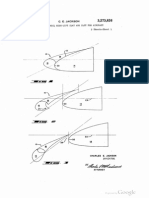Slots Vs Slats
What are the pros and cons of the hinged leading edge slats vs the fixed leading slots? Fixed leading edge slats have a fixed rather high drag component. A well designed hinged slat will blend into the leading edge at cruise speeds without a drag penalty. Steve Pierce., 06:54 AM. A leading edge slot is basically a spanwise opening in the wing. Slats are aerodynamic surfaces in the leading edge, which when deployed, allows the wing to operate at higher angle of attack. When deployed, the slat opens up a slot between itself and the wing.
Slots Vs Slats Vs
Question:
Can I remove the fixed leading edge slats of my STOL CH 701 and replace them with vortex generators (VGs)?:
Slats are deployed. The slat moves outwards and/or downwards to create a slot. The region of low static-pressure over the wing is now connected to the region of high static-pressure pressure under the wing. The energized airflow from under the wing is sucked up above the wing. As nouns the difference between slat and slot is that slat is a thin, narrow strip or bar of wood or metal while slot is a broad, flat, wooden bar, a slat, especially as used to secure a door, window, etc or slot can be a narrow depression, perforation, or aperture; especially, one for the reception of a piece fitting or sliding in it or slot can be the track of an animal, especially a deer.

The following short article is in answer to the above question asked to designer Chris Heintz on his opinion regarding the replacement of the wing leading edge slats with vortex generators (or VGs) on the STOL CH 701 (or CH 801):
By Chris Heintz
When you remove the wing’s leading-edge slats, the wing chord is decreased. This increases the wing loading as well as the aspect ratio:
Slots Vs Slats For Fencing
- An increased wing loading will need a higher lift coefficient for the same flying speed (resulting in a higher angle of attack and thus limiting forward visibility).
- A larger aspect ratio will slightly decrease the induced drag of the wing
- Both together will have a very small drag decrease in cruise as the wing drag is only a part of the total airplane drag (and my STOL designs are not very “clean”), and the stall speed will be higher.
The airfoil of my STOL airplanes is relatively thick with an unusually large leading edge radius. On this type of airfoil vortex generators (also called micro-vortex generators, or VGs) add very little improvement with respect to the maximum lift coefficient (or stall speed). Without slats the high lift coefficient allowing take-offs is only achieved in ground effect (it is when the wheels are only 2 to 3 feet above the runway) so you have to accelerate at this low height before you can climb safely. By adding VGs you do not need as much speed to climb than without the slats, but with leading edge slats you can climb immediately after rotation (thereby maximizing the short field capability of the aircraft)
The same is also true when landing the aircraft:
The high sink rate (or lower glide ratio) of a STOL airplane allows it to land in a smaller area. This is best achieved with the leading edge wing slats:
A higher glide ratio increases the area required to land an aircraft in, and thus diminishes the STOL capability of an aircraft.
From a design standpoint, I have no objection to the removal of the leading edge slats (and their attachment brackets) and replacing them with VGs, but be aware that the take-off distance will be longer and the initial climb rate will not be as good (nor will your approaches over trees be as steep), and the cruise speed will only increase slightly. I added “STOL” to the name of the CH 701 and CH 801 designs right from the beginning so that it would be immediately obvious that the designs are made for short take-offs and landings (STOL), and replacing the slats with VGs diminishes the STOL capability of these designs.

Use of Vortex Generators:
The use of vortex generators is quite intriguing in its own right (as opposed to replacing the wing leading edge slats) and, when used properly, may improve the stall on small leading edge radius airfoils (so-called laminar airfoils) by “pumping” energy from the free airstream into the boundary layer which will then separate at a higher angle of attack, and the airfoil will have a larger maximum lift coefficient, thus reducing the stall speed.
Note also that because of the above-mentioned “energizing” of the boundary layer with the use of VGs, the local stall can be delayed on a large deflection of a control surface, as illustrated below on the STOL elevator:

STOL CH 701 and CH 801 Horizontal Tail Sections (side view)
To better understand why (and how) I designed my STOL airplanes the way that I did, I wrote that following article a few years ago: “Anatomy of a STOL Airplane”
Note: It’s my experience that those individuals claiming great “cure-all” results with VGs are also the very same people that are trying to sell them to you, so I’m somewhat skeptical of their claims.
© Chris Heintz, 2007

Related Article: Anatomy of a STOL Aircraft:Designing a Modern Short Take-Off and Landing Aircraft.
Click here to read other Chris Heintz design articles.
Additional resources about vortex generators:
Zenith Aircraft Company |